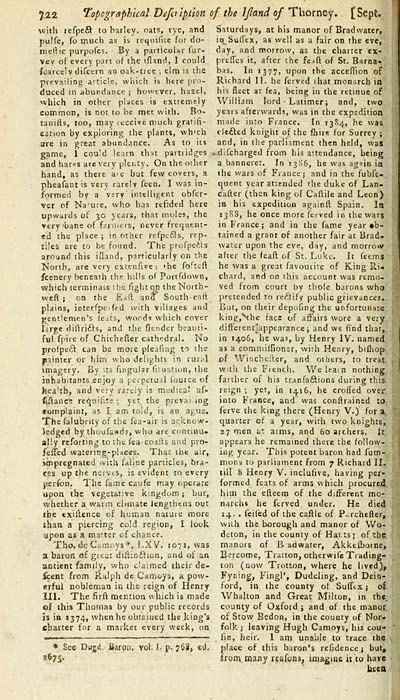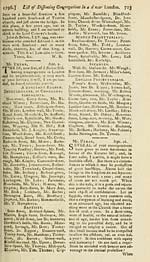Download files
Complete book:
Individual page:
Thumbnail gallery: Grid view | List view

722 Topographical Defctlpikn of the IJland of T homey. [Sept,
\vith »efpe6t to barley, oats, rye, and
pulfe, fo much as is reqnifite for do-
niel^ic purpofes. By a paiticular fur-
vey of every part of the ifl^nd, I could
fcarcelvdifcern an oak-tree ; elm is the
prevailing article, which is here [iro-
duced in abundance ; however, hazel,
'•vhich in other places is extremely
common, is not to he met with. Bo-
tanills, too, may itceivemuch gratifi-
cation by exploring the plants, wh'ch
are in great abundance. As to its
game, 1 could learn that partridges
and har«s are very plenty. On the other
hand, as there are but few covers, a
pheafant is very rarely feen. I was in-
formed by a vsry intcllii^ent obfer-
ver of Na'ure, who has refided here
upwards of 3c years, that moles, the
very 'bane of farmers, never frequent-
ed the place; in other refpefls, rep-
tiles are to be found. The profpeth
around this ifland, particularly on the
North, are very extenfive ; the fofteft
fcenery beneath the hills of Portfdown,
which terminate the fight on the North-
weft ; on the Eift and South- eaft
plains, interfpe'fed with villages and
gentlemen's leats, woods which cover
large dillriifs, and the flender bsaiui-
fui fpire of Chicheaer cathedral. No
profpeft can be more pleafing to the
painter or him who delights in rural
imagery. By its fingulsr fuuatinn, the
jnhabitantsenjoy a perpetual iource of
health, and very rarely is miidica! af-
fiflanc? requifite :, yet the prev&iing
tornpiaint, as I am told, is an ague.
Thefalubnty of the fea-alr is arknow-
Jedged by thoufasdj, who are continu-
ally reforting to the fea-coaih and pro»
felled vvaterir.g-pijces. Thar the air,
impregnated with faiine particles, bra-
ces up the nervt.s, is evident to every
perfon. The fame caufe may operate
upon the vegetative kingdom ; bur,
whether a wariTi climate lengtiiens oiit
the txiilence cf human nature more
than a piercing cold region, I look
upon as a matter of chance.
Tho.de Camoys*, LXV. 1071, was
a baron of great dillin£lion, and of an
antient family, who claimed their de-
cent from Ralph de Camoys, a pow-
erful nobleman iii the reign of Henry
III. The firft mention which is made
of this Thomas by our public records
is in 1374, when he obtained the king's
charter for a market every week, on
* See Dugd, JJaron. vol, I. p. 768, ed.
X675,
Saturdays, at his manor of Bradwater,
in__Suirex, as well as a fair on the eve,
day, and morrow, as the charter ex-
prtffes it, after the fe.ft of St. Barna-
bas. In 1377, upon the accefiion of
Richard II. he ferved ihat monarch in
his fleet ar fea, being in the retinue of
William lord - Latimer; and, two
years afterwards, was in the expedition
made into France. In 13S4, he was
elefted knight of the fhire for Surrey ;
and, in the parliament then held, was
H.difcharged from his attendance, being
a banneret. In 1386, he was ag^in ia
the wars of France; and in the fubfe-
quent year attended the duke of Lan-
c'after (then king of Caftile and Leon)
in his expedition againft Spain. In
13RS, he once more ferved in the wars
in France; and in the fame year •b-
tained a grant of another fair at Brad-
water upon the eve, day, and morrow
after the feaft of St. Luke. It feems
he was a great favourite of King Ri-
chard, and on this account was remo-
ved from court by thofe barons who
pretended to rei^tify public grievances.
But, on their depofing the unfortunate
king,Nhe face of affairs wore a very
different]appearance; and we find that,
in 1406, he was, by Henry IV. named
as a commiffionsr, with Henry, bifliop ,
of Wincheiler, and others, to treat, j
With the French. Weltam nothing :
farther of his tranfaftions during this 1
reign ; yet, in 1416, he croffed over .
into France, and Was conftrained to '
ferve the king there (Henry V.) for a *
quarter of a year, with two knights, ;
27 men at arms, and 60 archers. It
appears he remained there the follow- ;
ing year. This potent baron had fum- ,
mons to parliament from 7 Richard II. \
till 8 Henry V. inclufive, having per- ;
formed feats of arms which procured, \ '
him the efteem of the different mor
narchs he ftrved under. He died ;
14. . Icifed of the caftle of P.rchefter» ,
with the borough and manor of Wo- 1
deton, in the county of Harts; of the '
manors of B adwater, Akkelborne,
Bercome, Tratton, otherwife Trading-
ton (now Trotton, where he lived),
J^^y'^g* Fi"gl'» Dudeling, and Dein-
ford, in the county of Suffix; of
Whalton and Great Milton, in the.
county of Oxford ; and of the manor
of Stow Bedon, in the county of Nor-
folk ; leaving Hugh Camoys, his cou-
. fin, heir. I am unable to trace the
place of this baron's refidence ; but»
from many reafons, imagine it to have
bcea
\vith »efpe6t to barley, oats, rye, and
pulfe, fo much as is reqnifite for do-
niel^ic purpofes. By a paiticular fur-
vey of every part of the ifl^nd, I could
fcarcelvdifcern an oak-tree ; elm is the
prevailing article, which is here [iro-
duced in abundance ; however, hazel,
'•vhich in other places is extremely
common, is not to he met with. Bo-
tanills, too, may itceivemuch gratifi-
cation by exploring the plants, wh'ch
are in great abundance. As to its
game, 1 could learn that partridges
and har«s are very plenty. On the other
hand, as there are but few covers, a
pheafant is very rarely feen. I was in-
formed by a vsry intcllii^ent obfer-
ver of Na'ure, who has refided here
upwards of 3c years, that moles, the
very 'bane of farmers, never frequent-
ed the place; in other refpefls, rep-
tiles are to be found. The profpeth
around this ifland, particularly on the
North, are very extenfive ; the fofteft
fcenery beneath the hills of Portfdown,
which terminate the fight on the North-
weft ; on the Eift and South- eaft
plains, interfpe'fed with villages and
gentlemen's leats, woods which cover
large dillriifs, and the flender bsaiui-
fui fpire of Chicheaer cathedral. No
profpeft can be more pleafing to the
painter or him who delights in rural
imagery. By its fingulsr fuuatinn, the
jnhabitantsenjoy a perpetual iource of
health, and very rarely is miidica! af-
fiflanc? requifite :, yet the prev&iing
tornpiaint, as I am told, is an ague.
Thefalubnty of the fea-alr is arknow-
Jedged by thoufasdj, who are continu-
ally reforting to the fea-coaih and pro»
felled vvaterir.g-pijces. Thar the air,
impregnated with faiine particles, bra-
ces up the nervt.s, is evident to every
perfon. The fame caufe may operate
upon the vegetative kingdom ; bur,
whether a wariTi climate lengtiiens oiit
the txiilence cf human nature more
than a piercing cold region, I look
upon as a matter of chance.
Tho.de Camoys*, LXV. 1071, was
a baron of great dillin£lion, and of an
antient family, who claimed their de-
cent from Ralph de Camoys, a pow-
erful nobleman iii the reign of Henry
III. The firft mention which is made
of this Thomas by our public records
is in 1374, when he obtained the king's
charter for a market every week, on
* See Dugd, JJaron. vol, I. p. 768, ed.
X675,
Saturdays, at his manor of Bradwater,
in__Suirex, as well as a fair on the eve,
day, and morrow, as the charter ex-
prtffes it, after the fe.ft of St. Barna-
bas. In 1377, upon the accefiion of
Richard II. he ferved ihat monarch in
his fleet ar fea, being in the retinue of
William lord - Latimer; and, two
years afterwards, was in the expedition
made into France. In 13S4, he was
elefted knight of the fhire for Surrey ;
and, in the parliament then held, was
H.difcharged from his attendance, being
a banneret. In 1386, he was ag^in ia
the wars of France; and in the fubfe-
quent year attended the duke of Lan-
c'after (then king of Caftile and Leon)
in his expedition againft Spain. In
13RS, he once more ferved in the wars
in France; and in the fame year •b-
tained a grant of another fair at Brad-
water upon the eve, day, and morrow
after the feaft of St. Luke. It feems
he was a great favourite of King Ri-
chard, and on this account was remo-
ved from court by thofe barons who
pretended to rei^tify public grievances.
But, on their depofing the unfortunate
king,Nhe face of affairs wore a very
different]appearance; and we find that,
in 1406, he was, by Henry IV. named
as a commiffionsr, with Henry, bifliop ,
of Wincheiler, and others, to treat, j
With the French. Weltam nothing :
farther of his tranfaftions during this 1
reign ; yet, in 1416, he croffed over .
into France, and Was conftrained to '
ferve the king there (Henry V.) for a *
quarter of a year, with two knights, ;
27 men at arms, and 60 archers. It
appears he remained there the follow- ;
ing year. This potent baron had fum- ,
mons to parliament from 7 Richard II. \
till 8 Henry V. inclufive, having per- ;
formed feats of arms which procured, \ '
him the efteem of the different mor
narchs he ftrved under. He died ;
14. . Icifed of the caftle of P.rchefter» ,
with the borough and manor of Wo- 1
deton, in the county of Harts; of the '
manors of B adwater, Akkelborne,
Bercome, Tratton, otherwife Trading-
ton (now Trotton, where he lived),
J^^y'^g* Fi"gl'» Dudeling, and Dein-
ford, in the county of Suffix; of
Whalton and Great Milton, in the.
county of Oxford ; and of the manor
of Stow Bedon, in the county of Nor-
folk ; leaving Hugh Camoys, his cou-
. fin, heir. I am unable to trace the
place of this baron's refidence ; but»
from many reafons, imagine it to have
bcea
Set display mode to: Large image | Transcription
Images and transcriptions on this page, including medium image downloads, may be used under the Creative Commons Attribution 4.0 International Licence unless otherwise stated. ![]()
| Early Gaelic Book Collections > Ossian Collection > Gentleman's magazine, and historical chronicle > Volume 66, Part 2 > (200) |
|---|
| Permanent URL | https://digital.nls.uk/79424171 |
|---|
| Description | Selected books from the Ossian Collection of 327 volumes, originally assembled by J. Norman Methven of Perth. Different editions and translations of James MacPherson's epic poem 'Ossian', some with a map of the 'Kingdom of Connor'. Also secondary material relating to Ossianic poetry and the Ossian controversy. |
|---|
| Description | Selected items from five 'Special and Named Printed Collections'. Includes books in Gaelic and other Celtic languages, works about the Gaels, their languages, literature, culture and history. |
|---|

